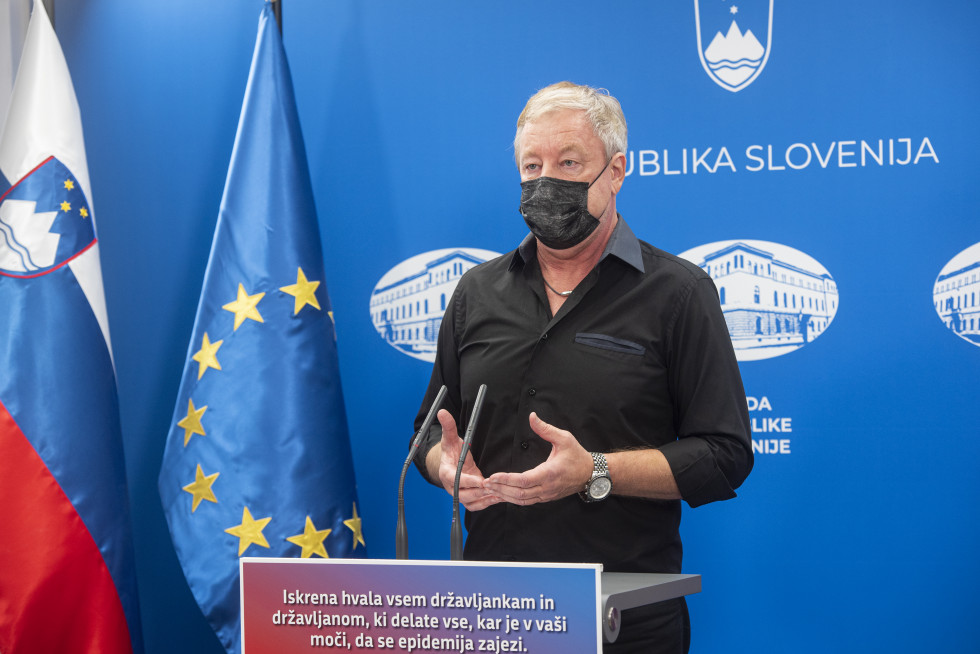In less than 24 hours, interest in receiving the vaccine has been expressed by almost 17,000 people

Borut Štrukelj | Author Bor Slana/STA
Yesterday, 2,139 new infections were confirmed from 7,003 tests, which means that the share of positive tests was 30.5 percent. The share of positive tests is 3.3 percent lower than the same share last Tuesday. Compared to last Tuesday, 290 fewer new infections were confirmed.
With regard to newly confirmed infections, the following municipalities stand out:
- Murska Sobota 30, Ljutomer 23,
- Novo mesto 88, Krško 55, Sevnica 32,
- Celje 33, Velenje 60,
- Maribor 93, Ptuj 30, and
- Ljubljana 169 cases. Ivančna Gorica with 34 and Medvode with 27 newly confirmed cases stand out in the vicinity of Ljubljana.
- There were 22 newly confirmed cases in Postojna, 45 in Koper, 34 in Idrija,
- 52 in Kranj, and 22 in Tržič.
The Ministry of Public Administration announced that 13,594 expressions of interest in receiving the vaccine had been submitted via applications without e-ID and 3,336 via applications with e-ID. That means a total of 16,930 expressions of interest in receiving the vaccine.
Yesterday, 1,282 COVID-19 patients required hospital treatment, which is 22 fewer than the day before, and 198 patients required intensive care, which is 5 more than on Monday. 38 patients died, i.e. 24 in hospitals and 14 in care homes.
267 residents of care homes have recovered, as well as 57 employees, of those 52 health professionals. There were 111 residents of care homes who tested positive yesterday, as well as 56 employees, of those 35 health professionals. The presentation of the situation in care homes concluded Mr Kacin’s presentation of epidemiological data.
The numerous pressing questions concerning the vaccines were answered by Mr Štrukelj. Three manufacturers submitted the application for the authorisation of the vaccine for general use to the European Medicines Agency (EMA). The Agency plans to approve the Pfizer vaccine on 29 December. The vaccines manufactured by Moderna and AstraZeneca are still in the process of receiving approval.
Both Pfizer’s and Moderna’s vaccines are mRNA-based, while AstraZeneca’s vaccine uses the established DNA technology. The vaccines differ in terms of storage temperature. The Pfizer vaccine needs to be stored at minus 70 degrees Celsius, Moderna’s at minus 20, and AstraZeneca’s at 2 to 8 degrees Celsius. All three vaccines are more than 90 percent effective and protect against the disease for one year. There are no major differences when it comes to the vaccination regime: for the first two vaccines, the doses must be administered 21 apart and AstraZeneca’s one month apart. The vaccine is effective within ten days after receiving the second dose.
The share of the population deciding for flu vaccination is increasing in Slovenia. Two years ago (winter of 2018/2019), this share was 5 percent, a year ago 7 percent, and in this year’s period 12 percent. This number would have been even higher had there been enough vaccination available. Finally, Mr Štrukelj emphasised that the level of responsibility for vaccination was very high in Scandinavia and that these countries should serve as an example of a responsible attitude towards vaccination.
Mr Deisinger presented the situation in the Izola General Hospital, saying that a COVID-19 department has been set up in the hospital since 20 October. Today, there are 57 patients hospitalised, 4 of them in intensive care. The hospital currently employs 860 people and 107 of them are on sick leave at the moment. The hospital started using rapid tests for its employees a fortnight ago. Out of 10 rapid antigen tests approximately 2 show a false positive, which is shown by PCR testing.
Analysing epidemiological data, Ms Grilc drew attention to the situation in care homes. The total number of active cases is high; however, in the last few days it has shown a minimal decline.
With regard to the sources of infection, Ms Grilc said that the respondents place work organisations at the top, i.e. close to 26 percent of them; however, she also said that 28 percent of the respondents do not know where they got infected. These infections could be attributed to various parties, a fact that respondents withhold.

